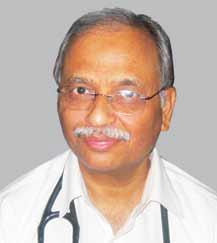G N Saxena, Professor, SMS Medical College (Retired)
“As people grew more familiar with computerised processes, we started increasing the amount of work being done by computers in our hospitals,” says G N Saxena, Professor, SMS Medical College (Retired), in a conversation with Nayana Singh

Telemedicine as a technology has been introduced in Rajasthan for quite some time. How has it benefitted the people of the state?
We brought in telemedicine in the state of Rajasthan six years ago. It started in the form of a pilot project in one district which was linked to Jaipur. Within a few months, other districts within the state were connected to district hospitals. Thereafter, district hospitals were connected to medical colleges, and all medical colleges were connected to each other. Telemedicine was established in Rajasthan with the help of ISRO, which provided us with satellite connectivity and the required bandwidth and the state government provided the required infrastructure for the project. Education is a key component of telemedicine, which acted as a platform for knowledge exchange. Topics were assigned to various districts for discussions and demands for discussions on specific topics were also placed from the districts. These discussions brought in a lot of solutions during times of crisis and epidemics, when the state was affected by bird flu and swine flu.

How was the computerisation of hospitals completed and to what extent did it benefit the people?The operations at hospitals started becoming computerised almost five years ago. Huge number of patients pay visit to the government hospitals on a regular basis. So initially the administrative workings of hospitals such as registration of patients, data collection, and investigative facility – all began to be computerised. As people grew more familiar with computerised processes, we started increasing the amount of work being done by computers. We started digitally storing patients’ demography, history, etc. Maximum benefit of this new method was felt by the patients as they could now see their reports online. They could access the information from anywhere and did not have to travel for long distances for the same.
A lot of technology is being constantly incorporated in the medical world. So how do you ensure that the syllabus at medical colleges is getting updated accordingly?
The curriculum taught to medical students are constantly being updated. Moreover, the website contains a lot of information — both for the graduate course as well as for the post graduate course. Most of the students are computer savvy and therefore, can catch up with the developments quite rapidly. We are also establishing e-libraries in all the six medical colleges throughout the state. So now, a lecture which is being delivered at Jaipur can be accessed from Kota, Bikaner, Jodhpur or any other part of the state. We are planning it in such a way that it can be used both in the form of direct communication and also in the form of a store and forward form of communication.
Even though a lot of progress is being witnessed in the field of medicine, malpractices such as female infanticide still persist in the state. Please highlight the initiatives that have been adopted to address the alarming issue?
Education is the only medium which we can change mindset of people. Developments in the fields of telemedicine, computerisation, along with several other progresses are acting as stepping stones towards transformation of the society. The state government, through the electronic media, has made sincere efforts to reach out to even the most distant villages and educate the folks about such social evils.
Can you share your experience regarding any particular project which distinctly stands out in your mind which has brought remarkable benefits to people?
The online reporting of investigations has been a great success. No other state government has been able to put up investigative reports online. Also, the biometric identification of donors have drastically reduced the number of professional blood donors. In our country, people still believe that donating blood will make them weak. The biometric way of identifying donors has been a major success.
Be a part of Elets Collaborative Initiatives. Join Us for Upcoming Events and explore business opportunities. Like us on Facebook , connect with us on LinkedIn and follow us on Twitter, Instagram.












